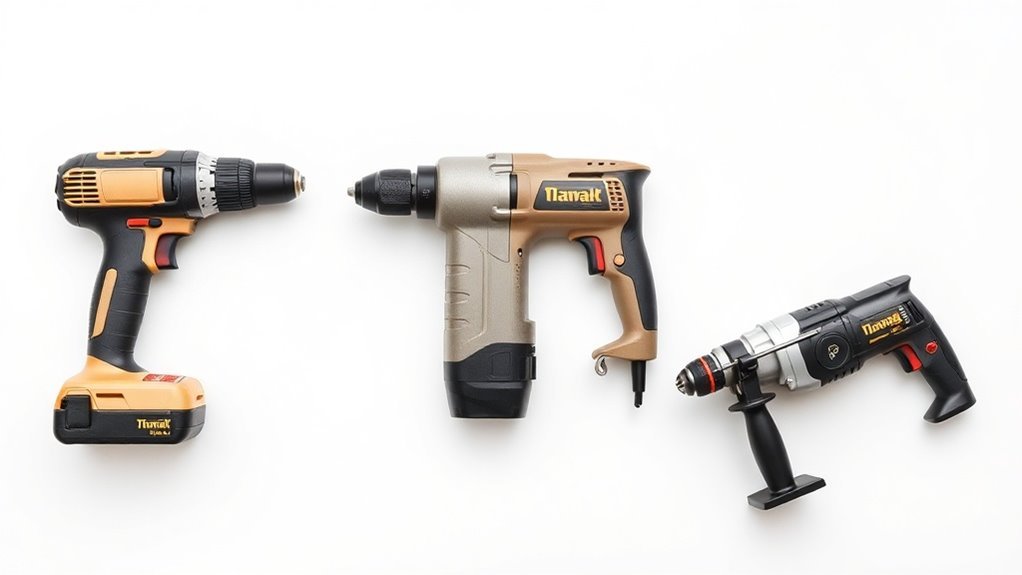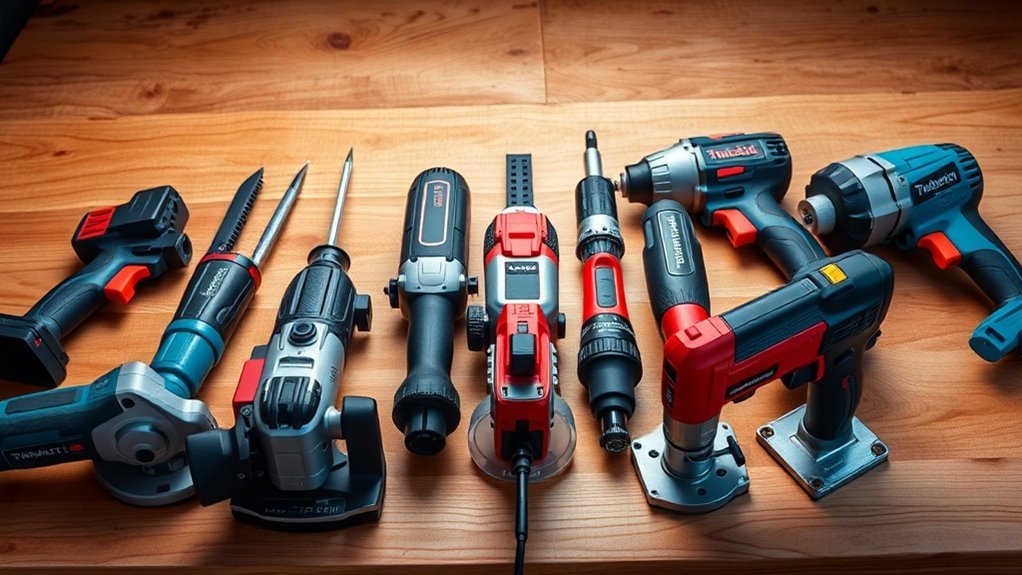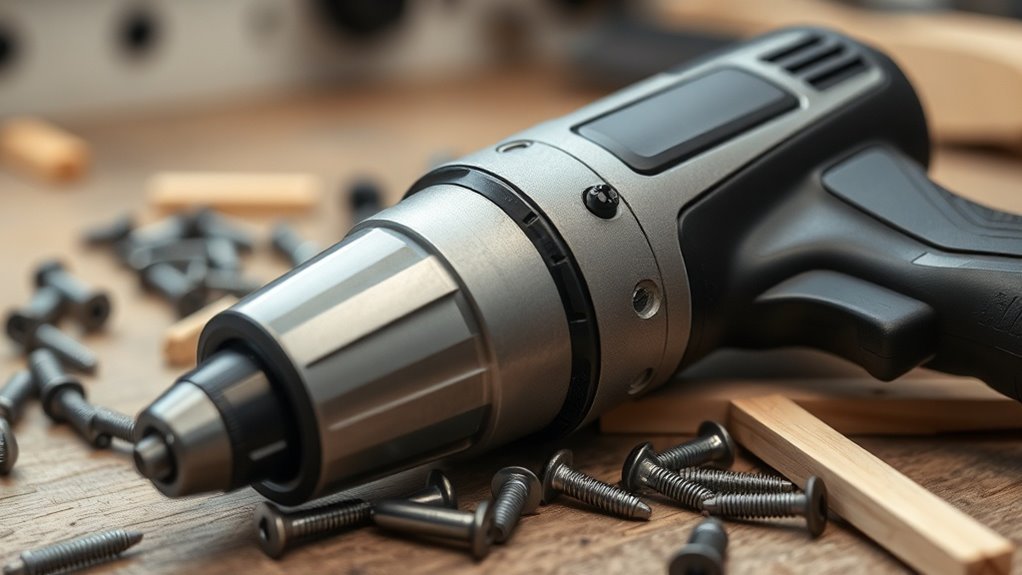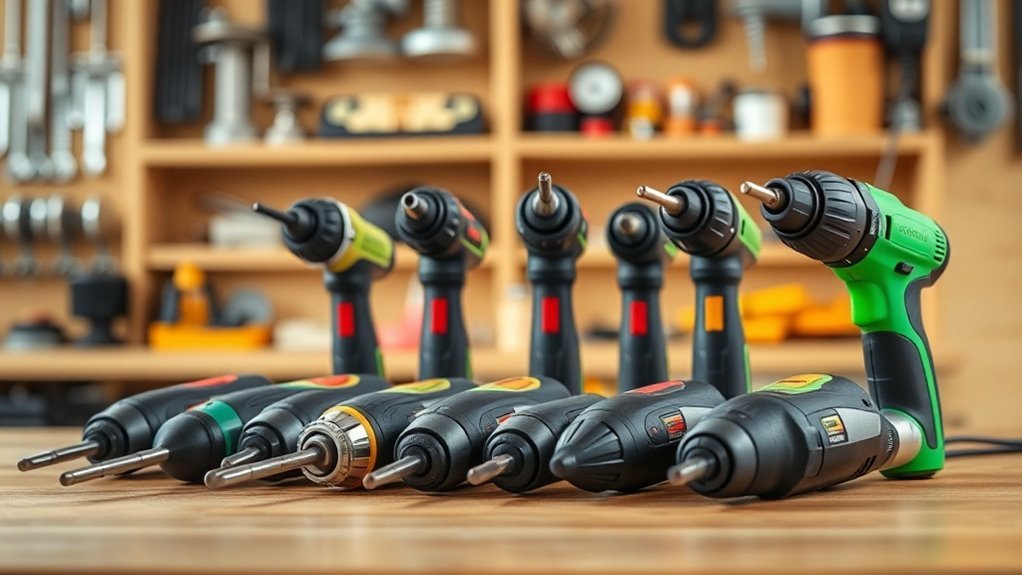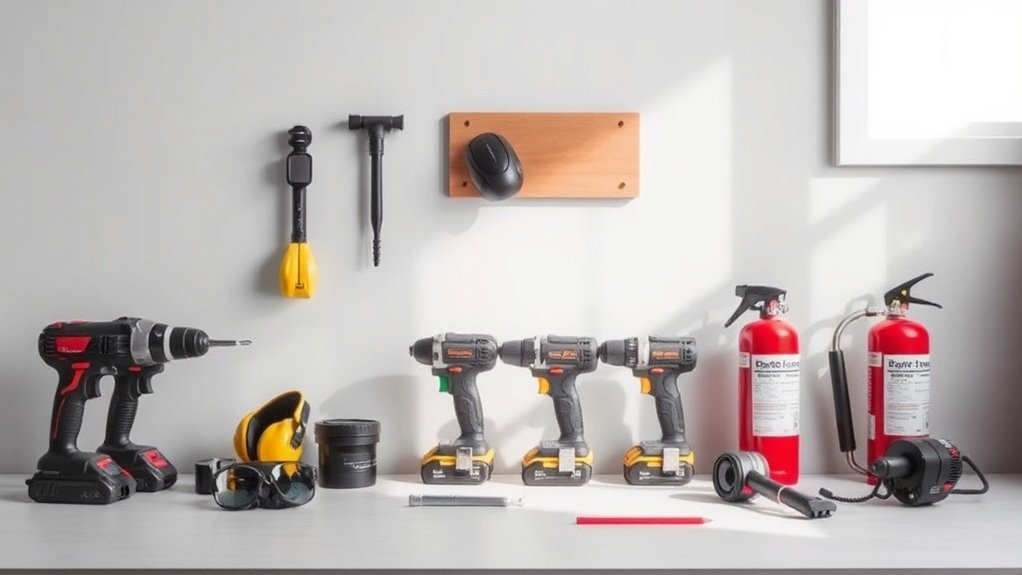Environmental Impact of Power Tools & Battery Recycling
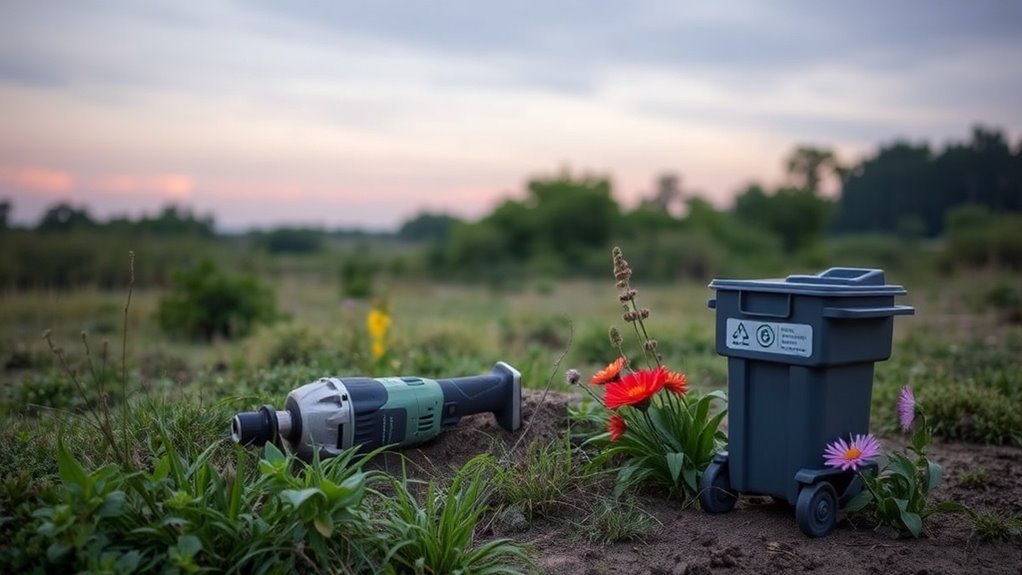
Power tools have a notable environmental impact from production to battery disposal. Manufacturing them consumes significant resources and energy, while the batteries used can leak toxic materials if not disposed of properly. Recycling batteries helps mitigate these hazards and recovers valuable materials. Choosing quality tools and maintaining them properly can also minimize waste and energy use. Explore how innovative, eco-friendly power tools can further reduce your carbon footprint and enhance your sustainable practices.
Key Takeaways
- Power tools produce significant environmental impacts through resource depletion, pollution, and carbon emissions during both manufacturing and usage stages.
- Lithium-ion batteries, although efficient, pose disposal risks due to toxic materials, promoting the need for responsible recycling to protect ecosystems.
- Recycling batteries conserves resources like lithium and cobalt while preventing toxic materials from leaching into the environment, benefiting human health and wildlife.
- Investing in quality tools enhances longevity and energy efficiency, ultimately reducing overall waste and the environmental footprint.
- Eco-friendly innovations in tool design and sustainable power sources, like renewable energy and recycled materials, help mitigate the environmental effects of power tools.
The Production Process of Power Tools
When you consider the production process of power tools, it’s crucial to understand the various stages involved that can impact the environment.
First, raw materials like metals and plastics are extracted, requiring significant land use and resources.
The manufacturing stage follows, where energy consumption is high, and waste production can increase if not managed properly.
Assembly operations often involve hazardous substances, which may pose risks if not handled appropriately.
Packaging materials contribute to waste, too, especially if they’re not recyclable.
Each of these stages has the potential to generate pollution and deplete natural resources.
As a consumer, being aware of these processes helps you make informed choices about the tools you buy and encourages manufacturers to adopt more sustainable practices.
Emissions and Resource Consumption
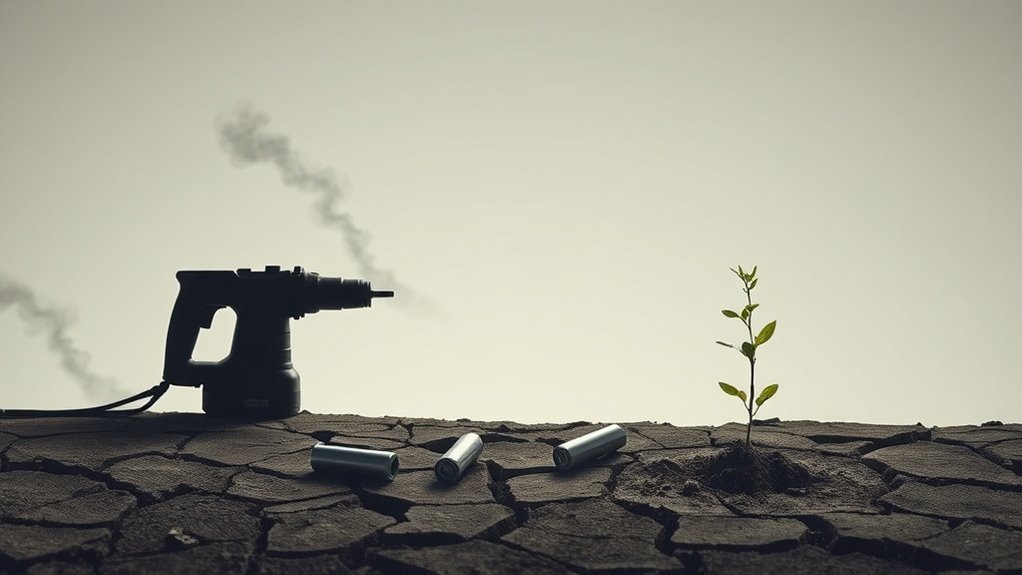
The environmental impact of power tools doesn’t stop at their production. When you use these tools, they contribute to emissions and resource consumption. Many electric power tools rely on energy generated from fossil fuels, which leads to carbon emissions. Even when using renewable energy, the demand for power isn’t negligible.
Furthermore, the components in these tools—like metals and plastics—require mining and extraction processes that further deplete natural resources and generate pollution. Each hour you run a power tool can seem lightweight, but collectively, countless users amplify the resource strain.
You can minimize these impacts by choosing energy-efficient tools, maintaining your equipment, and seeking ways to recycle or repurpose components when their lifecycle ends. It’s a small effort that adds up!
Types of Batteries in Power Tools
When you choose power tools, the type of battery can make a big difference in performance and environmental impact.
Lithium-ion batteries offer several advantages, like longer run times and faster charging, while NiCad batteries have some notable disadvantages, including toxic materials and shorter lifespans.
Understanding these options can help you make more eco-friendly choices for your projects.
Lithium-Ion Battery Advantages
Although many types of batteries are available for power tools, lithium-ion batteries stand out for their numerous advantages.
First, they offer a higher energy density, meaning you get more power in a lighter package. This makes your tools easier to handle and increases productivity.
You’ll also appreciate their longer lifespan, as lithium-ion batteries typically last two to three times longer than other types.
They charge quickly, often reaching full capacity in just an hour or so, which minimizes downtime during your projects.
Additionally, they’ve a lower self-discharge rate, so you can leave your tools unused for longer without worrying about battery drain.
NiCad Battery Disadvantages
While lithium-ion batteries are popular for their many benefits, it’s important to evaluate the disadvantages of nickel-cadmium (NiCad) batteries, which are still used in some power tools.
One major drawback is their shorter lifespan compared to lithium-ion options, which means you might find yourself replacing them more often.
NiCad batteries also suffer from the so-called “memory effect,” reducing their capacity if they’re not fully discharged before recharging.
Additionally, they contain toxic materials, including cadmium, which can harm the environment if not disposed of properly.
Handling the disposal is essential, as improper practices can lead to soil and water contamination.
Ultimately, while NiCad batteries can be effective, the ecological and performance issues may have you considering alternatives.
Environmental Hazards of Battery Disposal
When it comes to battery disposal, you could be contributing to significant environmental hazards.
Toxic materials from batteries can leach into the soil and water, while overflowing landfills make the problem even worse.
Plus, maneuvering through the challenges of environmental regulations makes proper disposal a complex issue you can’t overlook.
Toxic Materials Release
As you rely on power tools for various projects, you mightn’t consider the environmental impact of their batteries, particularly when it comes to disposal.
When improperly discarded, batteries can leak toxic materials like lead, cadmium, and lithium into the soil and water supply. These hazardous substances pose significant risks to both human health and wildlife.
Lead exposure can lead to neurological damage, while cadmium can affect your kidneys and bones. Even lithium, if released, can disrupt ecosystems.
Failing to recycle or dispose of batteries responsibly means these toxic materials can persist in the environment for years, causing long-term damage.
It’s essential to be mindful of how you handle battery disposal to mitigate these serious environmental hazards.
Landfill Overflow Issues
Improper disposal of batteries not only releases toxic materials into the environment but also contributes considerably to landfill overflow issues.
When you toss batteries in the trash, they end up in landfills, adding to the already overflowing waste. With growing battery use for power tools and other devices, the volume of discarded batteries is climbing.
These batteries can take decades to decompose, occupying precious landfill space and resulting in a serious waste management crisis. Plus, when they break down, they leach harmful chemicals, creating further environmental hazards.
You can help mitigate this issue by recycling batteries properly, ensuring they’re diverted from landfills. Making small changes, like using designated battery recycling centers, can make a big difference for our planet’s health.
Environmental Regulation Challenges
Despite advancements in environmental regulations, significant challenges remain in managing the disposal of batteries used in power tools. Improper disposal can lead to toxic leaks, harming both wildlife and human health. Unfortunately, many consumers still don’t understand the environmental risks associated with battery waste.
Here’s a quick overview of the key issues:
| Challenge | Impact |
|---|---|
| Lack of Consumer Awareness | Increased disposal risks |
| Inconsistent Regulations | Non-compliance issues |
| Limited Recycling Facilities | Higher landfill rates |
| Environmental Contamination | Harm to ecosystems |
Addressing these obstacles requires targeted education and stricter enforcement, ensuring batteries are disposed of properly, protecting the environment for future generations. Your awareness can make a real difference!
Benefits of Proper Battery Recycling
When you recycle batteries properly, you’re not just reducing waste; you’re also conserving valuable resources and minimizing environmental harm.
By doing so, you help recover essential materials like lithium, cobalt, and nickel, which are critical for making new batteries. This process decreases the demand for raw material extraction, reducing ecological damage and energy consumption associated with mining.
Furthermore, proper recycling prevents toxic materials from leaching into the soil and waterways, safeguarding wildlife and human health.
You’re also playing a part in promoting a sustainable economy, as recycled materials can be used to create new products.
Ultimately, by recycling your batteries, you’re contributing to a healthier planet for current and future generations.
Best Practices for Sustainable Tool Use
Proper battery recycling is just one part of a larger goal: using tools sustainably. To guarantee you’re minimizing your environmental impact, here are some best practices you can follow:
- Choose Quality Tools: Invest in durable tools that can withstand wear and tear. This reduces the need for replacements and cuts down waste.
- Maintain Your Tools: Regular maintenance extends the life of your tools. Clean, lubricate, and store them properly to keep them in peak condition.
- Use Energy-Efficient Power Sources: Whenever possible, opt for battery-powered or energy-efficient models. These can drastically reduce your carbon footprint compared to traditional options. Additionally, using tools with integrated sensors can further enhance energy efficiency and performance.
Innovations in Eco-Friendly Power Tools
As the demand for sustainable practices rises, manufacturers have been stepping up their game by developing innovative eco-friendly power tools that cater to both performance and environmental responsibility.
You’ll find tools made from recycled materials or equipped with energy-efficient motors that minimize electricity consumption.
Many brands are incorporating advanced battery technology, offering longer runtimes and quicker recharges while using less harmful materials.
Additionally, some tools utilize renewable resources, like solar power, which greatly reduces their carbon footprint.
These advancements not only help the environment but also enhance your work efficiency. Investing in energy-efficient power tools can lead to long-term savings on utility bills while minimizing your impact on the planet.
When you choose eco-friendly power tools, you’re making a conscious decision to support sustainability while enjoying high-quality performance, ensuring you’re part of a greener future.
Questions
How Do Power Tools Affect Wildlife Habitats?
Power tools can disturb wildlife habitats by causing noise pollution, disrupting natural behaviors, and damaging vegetation. When you use them in natural areas, it’s essential to take into account their impact on local ecosystems and wildlife safety.
What Is the Lifespan of Power Tool Batteries?
Like a well-tuned engine, power tool batteries typically last around three to five years, depending on usage and maintenance. If you charge them correctly and store them safely, you can maximize their longevity.
Are There Regulations for Battery Disposal in My Area?
Yes, there’re regulations for battery disposal in your area. You should check local waste management guidelines, as many communities provide special collection events or drop-off locations for proper battery recycling and disposal practices.
How Can I Reduce Power Tool Energy Consumption?
Cutting back your power tool energy consumption’s as simple as pie! You can choose energy-efficient models, unplug tools when not in use, and opt for manual alternatives whenever possible. Every little change counts!
What’s the Carbon Footprint of Manufacturing One Power Tool?
The carbon footprint of manufacturing one power tool varies, but it typically ranges between 20 to 100 kilograms of CO2 emissions. You can help reduce it by choosing energy-efficient tools and supporting sustainable brands.
Conclusion
To sum up, as you power up your tools, you’re not just building and fixing, you’re also influencing the planet. It’s a coincidence that your choice to recycle batteries could reduce emissions and protect nature, all while enjoying your projects. By embracing sustainable practices and opting for eco-friendly innovations, you’re not only crafting your creations but also crafting a greener future. So, the next time you reach for that tool, remember—your decisions make a difference!


